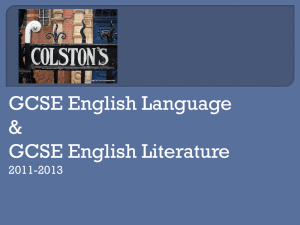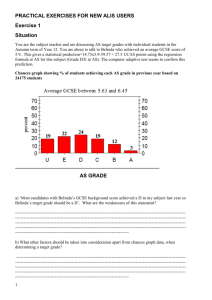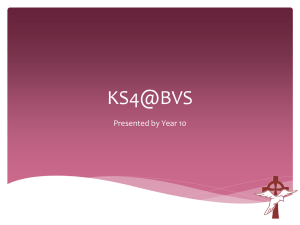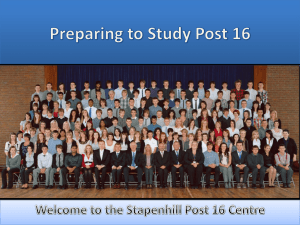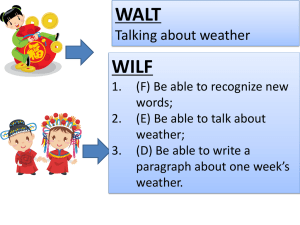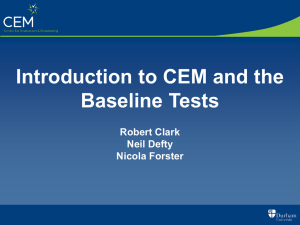Average Standardised Residual
advertisement
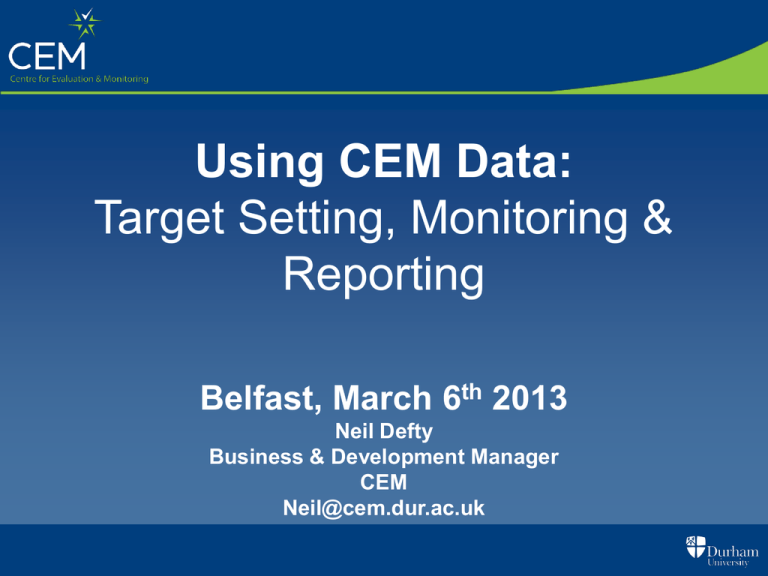
Using CEM Data: Target Setting, Monitoring & Reporting Belfast, March 6th 2013 Neil Defty Business & Development Manager CEM Neil@cem.dur.ac.uk Which Baseline to use? Student 1 Student 2 Student 3 Student 3 - IPR Key Questions for Target Setting • What type of valid and reliable predictive data should be used to set the targets? • Should students be involved as part of the process (ownership, empowerment etc.)? • Should parents be informed of the process and outcome? Key points to consider might include: • Where has the data come from? • What (reliable and relevant) data should we use? • Enabling colleagues to trust the data: Training (staff) • Communication with parents and students • Challenging, NOT demoralising, students…. • Storage and retrieval of data • Consistency of understanding what the data means and does not mean Value Added: The theory and Stats bits… . Measuring Value Added – Terminology Subject X Exam grade Outcome 120 100 80 -ve VA +ve VA 60 40 Residuals 20 BASELINE SCORE VA Trend Line/Regression Line Measuring Value Added – An Example National Trend ‘Average’ Student A* B Result C D -ve (- 2 grades) Aldwulf Beowulf Subject A +ve (+ 2 grades) Cuthbert E Subject B F G U Low Ability Average Ability High Ability Baseline Score The position of the national trend line is of critical importance Some Subjects are More Equal than Others…. A-Level A* 140 A 120 B Grade 100 >1 grade Photography Sociology 80 C English Lit Psychology Maths D 60 Physics Latin E 40 5 C 6 7 B A Average GCSE 8 A* Burning Question : What is my Value Added Score ? Better Question : Is it Important ? Value Added Charts Pre 16 VA Score Performance above expectation Good Practice to Share? Performance in line with expectation Performance below expectation Problem with Teaching & Learning? Danger of Relying on Raw Residuals Without Confidence Limits Which Subjects Cause Most Concern? 4 3 0.0 -0.3 -0.3 -2.9 -3 Short Course Religious Studies Spanish Science Religious Studies Physics Physical Education Music Mathematics History German Geography French English Literature English Drama Design & Technology Chemistry Business Studies Biology Art & Design Additional Science Additional Applied Science Which subjects now cause most concern ? 0.0 0.1 0.1 0.1 0.7 0.4 0.2 0.0 0.0 -0.4 -0.3 -1 0.2 0.2 0.5 1.0 0.5 1 0.8 1.1 2 0 -2 -4 Average Standardised Residual Average Standardised Residuals by Subject Business Studies Religious Studies Value Added Charts Post 16 SPC Chart VA Score Performance above expectation Good Practice to Share? Performance in line with expectation Performance below expectation Problem with Teaching & Learning? 2000 2001 2002 2003 2004 2005 Year 2006 2007 2008 2009 2010 Subject Summary - Subject Summary - Current Year 3 Year Average A2-English Literature Statistical Process Control (SPC) Chart 2008 2009 Year 2010 Student Level Residuals (SLR) Report Scatter Plot A2 – English Literature General Underachievement? Student Level Residuals (SLR) Report Scatter Plot A2 – English Literature Too many U’s? Other things to look for… Why did these students do so badly? Why did this student do so well? How did they do in their other subjects? Summary of Process • Examine Subject Summary • Determine ‘interesting’ (i.e. statistically significant) subjects • Look at 3 year average as well as single year if available • Look at trends in ‘Interesting Subjects’ • Examine student data – Scatter graphs • Identify students over / under achieving • Any known issues? • Don’t forget to look at over achieving subjects as well as under achieving Baseline Choice GCSE or Baseline Test? • • • • • Do students with the same GCSE score from feeder schools with differing value-added have the same ability? How can you tell if a student has underachieved at GCSE and thus can you maximise their potential? Has a student got very good GCSE scores through the school effort rather than their ability alone? Does school GCSE Value-Added limit the ability to add value at KS5? Can you add value at every Key Stage? The Effect of Prior Value Added Beyond Expectation In line with Expectation Below Expectation +ve Value-Added 0 Value-Added -ve Value-Added Average GCSE = 6 Average GCSE = 6 Average GCSE = 6 Do these 3 students all have the same ability? GCSE as Baseline Same School - Spot the Difference ? Test as Baseline National or School Type Specific? Comparison to all schools Comparison to Independent Schools Only Comparison to FE Colleges Only Comparison to all schools Questions: → → How does the unit of comparison used affect the Value Added data and what implications does this have on your understanding of performance? Does this have implications for Self Evaluation? Definitions: • Residual – difference between the points the student attains and points attained on average by students from the CEM cohort with a similar ability • Standardised Residual – the residual adjusted to remove differences between qualification points scales and for statistical purposes • Average Standardised Residual – this is the ‘Value Added Score’ for any group of results • Subject VA – average of standardised residuals for all students’ results in the particular subject • School VA – average of standardised residuals for all students’ results in all subjects for a school / college • Confidence Limit – area of statistical uncertainty within which any variation from 0 is deemed ‘acceptable’ and outside of which could be deemed ‘important’

